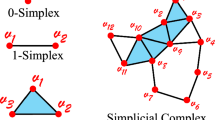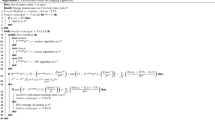Abstract
This paper presents a distributed, energy-aware method for the autonomous deployment and maintenance of battery-powered robots within a known or unknown region in 2D space. Our approach does not rely on a global positioning system and therefore allows for applications in GPS-denied environments such as underwater sensing or underground monitoring. After covering a region, our system maintains a formation and uses an arbitrary number of charging stations to prevent robots from fully discharging. Analyzing the topology of the network formed during robot deployment, we generate virtual recharging trees which the robots use to navigate toward a nearby charging station when needed. All robots that leave the formation are replaced by their neighbors, maximizing the effective coverage provided by the system. We demonstrate the capability of our methods using models, a physics-based simulator, and experiments with real robots.
























Similar content being viewed by others
Notes
The original problem of partitioning a graph into a forest is defined as: Given a graph \(G=\{V,E\}\) and a positive integer \( K \le |V|\), can the vertices of G be partitioned into k disjoint sets \(V_1, V_2, \ldots , V_k\), such that for \(1 \le i \le k\), the subgraph induced by \(V_i\) contains no circuits.
\(\cup ^z\) is a zip-union (inspired by Python zip()) operation, which results in a list having members intertwined as if connected with a zipper, for example let \( A = {1, 2, 3}\) and \(B = {a, b, c}\), then \( A \cup ^z B = {1, a, 2, b, 3, c} \).
The degree of a vertex in a graph indicates the number of edges connecting it to other vertices.
To simplify the notation, we define \(p_n=m\), i.e. the desired number of trees.
A graph without cycles where each vertex has the degree of 2 except the first and last one (Cormen et al. 2011).
The loop (line 5 of Algorithm 4) does not need to go through all the elements in \(R_C\) on each pass. Since the nodes with the highest degree and centrality are at the top of the list, by default Algorithm 4 takes the first one and declares it a root. This member is removed from \(R_C\), leaving the next (line 15) with the highest degree and centrality. Given the considered (triangular) graph shapes, it is very rare for the first member of \(R_C\) to not become a root.
An environment-mediated communication modality is found in insects and some unicellular organisms.
References
Blum, C., & Groß, R. (2015). Swarm intelligence in optimization and robotics. Springer handbook of computational intelligence (pp. 1291–1309). Berlin: Springer.
Cheah, C. C., Hou, S. P., & Slotine, J. J. E. (2009). Region-based shape control for a swarm of robots. Automatica, 45(10), 2406–2411.
Coleman, M., Lee, C. K., Zhu, C., & Hurley, W. G. (2007). State-of-charge determination from emf voltage estimation: Using impedance, terminal voltage, and current for lead-acid and lithium-ion batteries. IEEE Transactions on industrial electronics, 54(5), 2550–2557.
Cormen, T. H., Leiserson, C. E., Rivest, R. L., & Stein, C. (2011). Introduction to algorithms. McGraw: MIT Press.
Derenick, J., Michael, N., & Kumar, V. (2011). Energy-aware coverage control with docking for robot teams. In IEEE International Conference on Intelligent Robots and Systems (pp. 3667–3672)
Dorigo, M., Floreano, D., Gambardella, L. M., Mondada, F., Nolfi, S., Baaboura, T., et al. (2013). Swarmanoid: A novel concept for the study of heterogeneous robotic swarms. IEEE Robotics & Automation Magazine, 20(4), 60–71.
Erdelj, M., Natalizio, E., Chowdhury, K. R., & Akyildiz, I. F. (2017). Help from the sky: Leveraging UAVs for disaster management. IEEE Pervasive Computing, 16(1), 24–32.
Franchi, A., Oriolo, G., & Stegagno, P. (2013). Mutual localization in multi-robot systems using anonymous relative measurements. The International Journal of Robotics Research, 32(11), 1302–1322.
Freeman, L. C. (1978). Centrality in social networks conceptual clarification. Social Networks, 1(3), 215–239.
Fujinaga, N., Yamauchi, Y., Kijima, S., & Yamashita, M. (2012). Asynchronous pattern formation by anonymous oblivious mobile robots. Lecture Notes in Computer Science 7611 LNCS:312–325
Garey, M. R., & Johnson, D. S. (1990). Computers and intractability; A guide to the theory of NP-completeness. New York: W. H. Freeman & Co.
Guo, H., Meng, Y., & Jin, Y. (2011). Swarm robot pattern formation using a morphogenetic multi-cellular based self-organizing algorithm. In Robotics and Automation (ICRA), 2011 IEEE International Conference on, IEEE (pp. 3205–3210)
Güzel, M.S., Gezer, E.C., Ajabshir, V.B., & Bostancı, E. (2017). An adaptive pattern formation approach for swarm robots. In 2017 4th International Conference on Electrical and Electronic Engineering (ICEEE). IEEE (pp. 194–198)
Hagen, L., & Kahng, A. B. (1992). New spectral methods for ratio cut partitioning and clustering. IEEE Transactions on Computer-Aided Design of Integrated Circuits and Systems, 11(9), 1074–1085.
Hartigan, J. A., & Wong, M. A. (1979). Algorithm AS 136: A \(k\)-means clustering algorithm. Journal of the Royal Statistical Society Series C (Applied Statistics), 28(1), 100–108.
Hernandez-Martinez, E., & Aranda-Bricaire, E. (2012). Decentralized formation control of multi-agent robots systems based on formation graphs. Studies in Informatics and Control, 21(1), 7–16.
Hsieh, M. A., Kumar, V., & Chaimowicz, L. (2008). Decentralized controllers for shape generation with robotic swarms. Robotica, 26(5), 691–701.
Jin, Y., Member, S., Guo, H., & Meng, Y. (2012). A hierarchical gene regulatory network for adaptive multirobot pattern formation. IEEE Transactions on Systems, Man, and Cybernetics, Part B: Cybernetics, 42(3), 805–816.
Jungnickel, D., & Jungnickel, D. (2005). Graphs, networks and algorithms. Berlin: Springer.
Kemna, S., Rogers, J.G., Nieto-Granda, C., Young, S., & Sukhatme, G.S. (2017) Multi-robot coordination through dynamic Voronoi partitioning for informative adaptive sampling in communication-constrained environments. In 2017 IEEE International Conference on Robotics and Automation (ICRA). IEEE (pp. 2124–2130)
Kurazume, R., & Hirose, S. (2000). Development of a cleaning robot system with cooperative positioning system. Autonomous Robots, 9(3), 237–246.
Lee, D. T., & Schachter, B. J. (1980). Two algorithms for constructing a Delaunay triangulation. International Journal of Computer & Information Sciences, 9(3), 219–242.
Lennard-Jones, J. E. (1931). Cohesion. Proceedings of the Physical Society, 43(5), 461.
Li, G., Švogor, I., & Beltrame, G. (2017) Self-adaptive pattern formation with battery-powered robot swarms. In 2017 NASA/ESA Conference on Adaptive Hardware and Systems (AHS). IEEE (pp. 253–260)
McSherry, F. (2001). Spectral partitioning of random graphs. In Proceedings of 42nd IEEE Symposium on Foundations of Computer Science, 2001. IEEE (pp. 529–537)
Mei, Y., Lu, Y. H., Hu, Y. C., & Lee, C. G. (2006). Deployment of mobile robots with energy and timing constraints. IEEE Transactions on Robotics, 22(3), 507–522.
Mong-ying, A.H., & Kumar, V. (2006) Pattern generation with multiple robots. In Proceedings of 2006 IEEE International Conference on Robotics and Automation, 2006. ICRA 2006. IEEE (pp. 2442–2447)
Paley, D. A., Leonard, N. E., & Sepulchre, R. (2008). Stabilization of symmetric formations to motion around convex loops. Systems & Control Letters, 57(3), 209–215.
Pinciroli, C., & Beltrame, G. (2016). Buzz: A programming language for robot swarms. IEEE Software, 33(4), 97–100.
Pinciroli, C., Trianni, V., O’Grady, R., Pini, G., Brutschy, A., Brambilla, M., et al. (2012). ARGoS: A modular, parallel, multi-engine simulator for multi-robot systems. Swarm Intelligence, 6(4), 271–295.
Pinciroli, C., Lee-Brown, A., & Beltrame, G. (2015). A tuple space for data sharing in robot swarms. In 9th EAI International Conference on Bio-inspired Information and Communications Technologies (BICT 2015). ACM Digital Library (pp. 287–294)
Scherer, J., & Rinner, B. (2016) Persistent multi-UAV surveillance with energy and communication constraints. In 2016 IEEE International Conference on Automation Science and Engineering (CASE). IEEE (pp. 1225–1230)
Sepulchre, R., Paley, D. A., & Leonard, N. E. (2008). Stabilization of planar collective motion with limited communication. IEEE Transactions on Automatic Control, 53(3), 706–719.
Setter, T., & Egerstedt, M. (2017). Energy-constrained coordination of multi-robot teams. IEEE Transactions on Control Systems Technology, 25(4), 1257–1263.
Shiell, N., & Vardy, A. (2016) A bearing-only pattern formation algorithm for swarm robotics. In International Conference on Swarm Intelligence, Springer (pp. 3–14)
Spears, W. M., Spears, D. F., Hamann, J. C., & Heil, R. (2004). Distributed, physics-based control of swarms of vehicles. Autonomous Robots, 17(2), 137–162.
St-Onge, D., Varadharajan, V.S., Li, G., Svogor, I., & Beltrame, G. (2018). ROS and BUZZ: Consensus-based behaviors for heterogeneous teams. In [submitted to] International Conference on Intelligent Robots and Systems. IEEE. arXiv: 1710.08843
Støy, K. (2001). Using situated communication in distributed autonomous mobile robots. Proceedings of the 7th Scandinavian Conference on Artificial Intelligence (pp. 44–52)
Xu, H.X.H., Guan, H.G.H., Liang, A.L.A., & Yan, X.Y.X. (2010). A multi-robot pattern formation algorithm based on distributed swarm intelligence. 2010 Second International Conference on Computer Engineering and Applications (ICCEA) (pp. 71–75)
Acknowledgements
We thank our former laboratory member Carlo Pinciroli, who greatly influenced this work, and interns Christophe Bedard and Nghia Do for their assistance. This research was supported by the NSERC Strategic Partnership Grant 479149-2015.
Author information
Authors and Affiliations
Corresponding authors
Additional information
Publisher's Note
Springer Nature remains neutral with regard to jurisdictional claims in published maps and institutional affiliations.
Appendix A: Supplementary materials
Appendix A: Supplementary materials
Supplementary multimedia content accompanying this paper can be found at: http://mistlab.ca/papers/LongTermPattern/2017/
Rights and permissions
About this article
Cite this article
Li, G., Svogor, I. & Beltrame, G. Long-term pattern formation and maintenance for battery-powered robots. Swarm Intell 13, 21–57 (2019). https://doi.org/10.1007/s11721-019-00162-1
Received:
Accepted:
Published:
Issue Date:
DOI: https://doi.org/10.1007/s11721-019-00162-1




